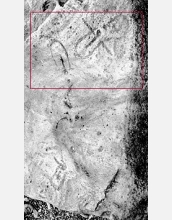News Release 99-030
Archeologists Find Milder Arctic Climate May Have Aided Aleutian Settlement
April 26, 1999
This material is available primarily for archival purposes. Telephone numbers or other contact information may be out of date; please see current contact information at media contacts.
A milder Arctic climate more than 3,000 years ago may have aided humans to cross the Bering Sea from Alaska and migrate into the remote Aleutian Island chain, according to preliminary findings by a three-woman research team funded by the National Science Foundation.
Dixie L. West, a professor of anthropology at the University of Kansas, said radiocarbon dating of bones found in an ancient midden, or refuse pit, on Shemya Island indicates that the westernmost Aleutians were settled roughly 3,500 years ago, or 1,000 years earlier than previously thought. Island soil and plant matter dated by Russian scientists indicates that the prevailing climate may have calmed the usually turbulent Bering Sea during that period, she added.
"This new environmental evidence indicates that the Northwest Pacific was becoming warmer and drier at that time. That may have allowed the Aleuts to take those first long, dangerous sea voyages," she said.
The team will return to the Aleutians in late May to further investigate evidence uncovered during the past three years that may help science to better understand how and when the most remote and isolated areas of North America were colonized.
"West and her team have uncovered many 'firsts' that will become vital pieces in the history and pre-history of the western Aleutian Islands," said Fae Korsmo, who oversees Arctic social science research in NSF's Office of Polar Programs.
The team was the first to identify a bone from a Stellar's sea cow, a large walrus-like animal, ever be found in the Aleutians east of the Commander Islands, adjacent to the Russian coast. The presence of the bone on Buldir Island may indicate that the animals lived in the Aleutians as well as the Commanders, and that humans moving westward from Alaska may have exterminated them from the eastern islands.
Buldir also is the site of the only whalebone house ever scientifically excavated in the Aleutians. Christine LeFevre, a team member with French Museum of Natural History, made the find while excavating a pit near the beach. Because of the position of the bones, "we could tell immediately that this wasn't a whale that had stranded on the beach and died there," West said. "In one side of the house, someone had excavated a pit and lined it with the shoulderblades of sea lions and they had placed a whale skull nose-down in the pit."
The whalebone house dates from the 15th century and it is almost certain that the island was occupied much earlier than that, though evidence of that occupation has yet to be found. But West noted that Buldir is difficult to land on even today and that perhaps Aleuts temporarily by-passed it and then returned later.
West also has obtained permission from the Aleut Corporation to remove bones that may be the remains of ancient Aleuts from a cave on Attu island. If the remains prove to be the bones of Aleuts, DNA sampling will allow for comparison with contemporary Aleuts and perhaps shed light on changes in nutrition and health as well as additional clues to the puzzle of migration patterns.
The team also will take a first look this field season at what it believes are the first petroglyphs--or stone carvings--discovered in the Aleutians. Debra Corbett, an archeologist with the U.S. Fish & Wildlife Service and a member of the NSF-funded team, said the carvings, which were found on automobile-sized rocks on a beach on Agattu Island, are the first evidence of such artwork on the Aleutian chain. Although some evidence of cave painting has been documented in the Aleutians, she said, "petroglyphs are pretty rare generally in Alaska, and there have never been any reported in the Aleutians. It's a major puzzle."
-NSF-
Media Contacts
Peter West, NSF, (703) 292-8070, email: pwest@nsf.gov
Program Contacts
Fae L. Korsmo, NSF, (703) 292-8040, email: fkorsmo@nsf.gov
The U.S. National Science Foundation propels the nation forward by advancing fundamental research in all fields of science and engineering. NSF supports research and people by providing facilities, instruments and funding to support their ingenuity and sustain the U.S. as a global leader in research and innovation. With a fiscal year 2023 budget of $9.5 billion, NSF funds reach all 50 states through grants to nearly 2,000 colleges, universities and institutions. Each year, NSF receives more than 40,000 competitive proposals and makes about 11,000 new awards. Those awards include support for cooperative research with industry, Arctic and Antarctic research and operations, and U.S. participation in international scientific efforts.
Connect with us online
NSF website: nsf.gov
NSF News: nsf.gov/news
For News Media: nsf.gov/news/newsroom
Statistics: nsf.gov/statistics/
Awards database: nsf.gov/awardsearch/
Follow us on social
Twitter: twitter.com/NSF
Facebook: facebook.com/US.NSF
Instagram: instagram.com/nsfgov



